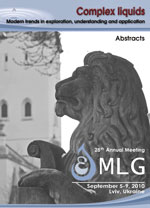One- and two-mode behavior of the n(C=O) band in N,N-dimethylforma-mide isotopic mixtures: DMF/DMF-d1, DMF/DMF-d6, and DMF/DMF-13CO
Maria Grazia Giorgini
Observation of the Raman spectrum of some binary isotopic liquid mixtures may cause a great surprise: the spectral merging of the bands associated with a given normal mode having slightly different intrinsic frequency in the two neat liquids, to only one band with a frequency located in between (one-mode behavior). It was noticed in the Raman spectrum of the amide I [(C=O)] band of formamide-d2/formamide-d3 liquid mixtures [1]. Both the overlap of the two bands and the dynamical D/H exchange could be excluded as possible origins of merging. The onset of this phenomenon requires the occurrence of very critical spectral conditions, because, while it is observed in the amide I band of the formamide-d2/formamide-d3 [1] mixtures, it is absent in the same mode of the analogous formamide/formamide-13CO mixtures [1] where the two-mode behavior is observed. To unveil the origin of this phenomenon and recognize which and how spectral conditions discriminate between the observation of the one- or two mode behavior, a computational procedure has been envisaged [2] based on the parametrization of the vibrational modes in a liquid coupled by transition dipole coupling mechanism (TDC). It is well known, in fact, that the (C=O) mode in liquid carbonyl compounds, and more notably in the amide I band present in amides, is affected by intermolecular resonant vibrational coupling as manifested by the frequency splitting between the Raman aniso- and isotropic components (termed noncoincidence effect, NCE), particularly large (15 cm-1) in these carbonyl compounds. It has been found [3] that the ingredient for the onset of the one-mode behavior is the extent of resonance condition (the magnitude of the resonant coupling compared with the separation of the wavenumber positions) between the vibrations of the two species and their bandwidths. With the present investigation we intend to analyse and discuss the one-/two-mode behaviour of the amide I band in isotopic mixtures of N,N-dimethylformamide (DMF) in the light of the general results obtained in [3] on the basis of a parametric analysis of a coupled oscillator system. Among the results (isotropic Raman spectra) obtained for the three types of isotopic mixtures under study, DMF/DMF-13C=O, DMF/DMF-d1 and DMF/DMF-d6, the latter system unambiguously indicates the occurrence of one-mode behavior (complete merging) of the (C=O) band whereas the first system unambiguously displays the two mode behavior (complete separation) of these bands.
References
- Mortensen A., Faurskov Nielsen O., Yarwood J., Shelley V., J. Phys. Chem. 1995, 99, 4435-4440
- Torii H., J. Phys. Chem. A 2006, 110, 4822-4832.
- Torii H., Osada Y., Iwami M., J. Raman Spectrosc. 2008, 39, 1592-1599



